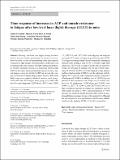Time response of increases in ATP and muscle resistance to fatigue after low-level laser (light) therapy (LLLT) in mice
Author(s)
Ferraresi, Cleber; Huang, Ying-Ying; de Sousa, Marcelo Victor Pires; Bagnato, Vanderlei Salvador; Parizotto, Nivaldo Antonio; Hamblin, Michael R.; ... Show more Show less
Download10103_2015_Article_1723.pdf (1002.Kb)
PUBLISHER_POLICY
Publisher Policy
Article is made available in accordance with the publisher's policy and may be subject to US copyright law. Please refer to the publisher's site for terms of use.
Terms of use
Metadata
Show full item recordAbstract
Recently, low-level laser (light) therapy has been used to increase muscle performance in intense exercises. However, there is a lack of understanding of the time response of muscles to light therapy. The first purpose of this study was to determine the time response for light-emitting diode therapy (LEDT)-mediated increase in adenosine triphosphate (ATP) in the soleus and gastrocnemius muscles in mice. Second purpose was to test whether LEDT can increase the resistance of muscles to fatigue during intense exercise. Fifty male Balb/c mice were randomly allocated into two equal groups: LEDT-ATP and LEDT-fatigue. Both groups were subdivided into five equal subgroups: LEDT-sham, LEDT-5 min, LEDT-3 h, LEDT-6 h, and LEDT-24 h. Each subgroup was analyzed for muscle ATP content or fatigue at specified time after LEDT. The fatigue test was performed by mice repeatedly climbing an inclined ladder bearing a load of 150 % of body weight until exhaustion. LEDT used a cluster of LEDs with 20 red (630 ± 10 nm, 25 mW) and 20 infrared (850 ± 20 nm, 50 mW) delivering 80 mW/cm[superscript 2] for 90 s (7.2 J/cm[superscript 2]) applied to legs, gluteus, and lower back muscles. LEDT-6 h was the subgroup with the highest ATP content in soleus and gastrocnemius compared to all subgroups (P < 0.001). In addition, mice in LEDT-6 h group performed more repetitions in the fatigue test (P < 0.001) compared to all subgroups: LEDT-sham and LEDT-5 min (~600 %), LEDT-3 h (~200 %), and LEDT-24 h (~300 %). A high correlation between the fatigue test repetitions and the ATP content in soleus (r = 0.84) and gastrocnemius (r = 0.94) muscles was observed. LEDT increased ATP content in muscles and fatigue resistance in mice with a peak at 6 h. Although the time response in mice and humans is not the same, athletes might consider applying LEDT at 6 h before competition.
Date issued
2015-02Department
Massachusetts Institute of Technology. Institute for Medical Engineering & Science; Harvard University--MIT Division of Health Sciences and TechnologyJournal
Lasers in Medical Science
Publisher
Springer London
Citation
Ferraresi, Cleber et al. “Time Response of Increases in ATP and Muscle Resistance to Fatigue after Low-Level Laser (Light) Therapy (LLLT) in Mice.” Lasers in Medical Science 30.4 (2015): 1259–1267.
Version: Author's final manuscript
ISSN
0268-8921
1435-604X